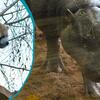As the first Scimitar-Horned Oryx Day approaches on 16 August, John Newby (Sahara Conservation) offers insight into this antelope's return from the brink of extinction:
Once roaming in vast herds across the Sahelian grasslands of North Africa, the scimitar-horned oryx (Oryx dammah) was declared Extinct in the Wild by the IUCN Red List of Threatened species in 2000. Its dramatic fall was the result of a deadly combination of overhunting and prolonged drought. But today, thanks to an extraordinary international conservation effort, anchored in rigorous monitoring and decades of commitment from zoos around the world, this iconic antelope has made a remarkable comeback in its native range in Ouadi Rimé – Ouadi Achim, in Chad.
The story of the scimitar-horned oryx’s return begins in captivity. While wild populations collapsed, a handful of oryx had been transported out of Africa in the 1960s and early 1970s, forming the foundation of what would be called “the World Herd”. The majority of these oryx, originating from Chad, were held in European and North American zoos and ranches, as well as private collections in the UAE. Carefully bred and managed over the decades, these captive "insurance populations" kept hope alive for reintroducing the species when the time was right.
That time came in 2016, when the first 25 oryx were flown from the Environment Agency of Abu Dhabi’s facilities to Chad and released in the 78,000 km² Ouadi Rimé–Ouadi Achim Faunal Reserve, native stronghold of the species. Since that historic release, over 380 oryx have been reintroduced, and by 2023, this iconic species was reclassified as Endangered (EN), with the wild population reaching over 600 individuals, a monumental milestone for conservationists.[1]
But reintroduction is only the beginning. Ensuring the survival of a free-ranging scimitar-horned oryx population requires intensive, ongoing monitoring. From the outset, Sahara Conservation, in partnership with Chad’s Government and international experts, established a robust system to track the oryx post-release. A permanent team based at the Oryx Base Camp in the reserve has been tasked with observing herd movements, collecting ecological data, and documenting births, deaths, and health status.
GPS collars have been indispensable. Carefully fitted to released or recaptured individuals, these collars provide real-time data on movement patterns, habitat use, and seasonal dispersal. This information helps conservationists understand how oryx adapt to environmental pressures, including droughts, disease, and competition with livestock. During dry years, for instance, monitoring has revealed declines in calf survival and shifts in grazing behavior, vital data for adapting management strategies.
In addition to field-based observations, genetic and health monitoring, led by zoo-based specialists, has been essential. Before release, scimitar-horned oryx from various captive populations underwent genetic screening to ensure a healthy, diverse founder population. Zoos across Europe and North America, including many BIAZA members, contributed animals, expertise, and logistical support to build what is now a genetically robust population in Chad.
The role of zoos has gone far beyond providing animals. Over the years, they have invested heavily in the science, strategy, and training that underpin the reintroduction. British institutions like Marwell Wildlife have been central to the effort, helping develop and manage early captive populations in Tunisia, training monitoring staff, and promoting the recovery of desert antelopes across the Sahel. The Zoological Society of London has also played a major role in field surveys, feasibility studies, and post-release assessments.
This collective effort has helped to ensure that the reintroduced scimitar-horned oryx are not simply surviving, but living independently in a vast, unfenced wilderness. Unlike in fenced reserves, the scimitar-horned oryx in Ouadi Rimé – Ouadi Achim must navigate natural risks like drought and diseases, without supplemental feeding or water provision. Monitoring enables conservationists to strike a balance between intervening when necessary and letting natural processes shape the population’s development.
Looking ahead, long-term success will depend on building sustainable coexistence between people and wildlife. The reserve is not a people-free zone: it is a multi-use landscape shared with local pastoralists. Monitoring teams now also gather data on land use, grazing patterns, and human-wildlife interactions. This helps inform land-use planning and the creation of “management zones” that accommodate both scimitar-horned oryx conservation and the needs of local herders.
International Scimitar-Horned Oryx Day is a celebration of what can be achieved when science, passion, and collaboration converge. It’s a story of resilience, of a species brought back from the brink, and of the global network of zoos, scientists, and conservationists who made it possible. Thanks to the meticulous work of monitoring teams and the enduring support of zoological institutions, the scimitar-horned oryx once again grazes the grasslands of Chad, symbolizing hope not just for a species, but for conservation at large.
- John Newby, Senior Advisor at Sahara Conservation
[1] In 2024, an exceptionally long, hot dry season resulted in higher than usual mortalities of wildlife and livestock, with significant consequences for the livelihoods and well-being of people who rely on natural resources in and around the reserve. While the oryx population showed remarkable resilience, recovering as conditions improved, it served as a stark reminder of the ongoing commitment required to secure enduring, positive outcomes for both nature and people.
All blogs reflect the views of their author and are not necessarily a reflection of BIAZA's position
Related Members
-
News
 Belfast Zoo helps to bring Christmas joy to Children’s Hospital 19th December, 2025Belfast Zoo joined the Lord Mayor of Belfast, Councillor Tracy Kelly, on Monday (15th December) to help bring festive cheer to the Royal Belfast Hospital…
Belfast Zoo helps to bring Christmas joy to Children’s Hospital 19th December, 2025Belfast Zoo joined the Lord Mayor of Belfast, Councillor Tracy Kelly, on Monday (15th December) to help bring festive cheer to the Royal Belfast Hospital… -
News
 Colchester Zoological Society welcomes new arrivals 19th December, 2025This December, Colchester Zoological Society (CZS) welcomed some exciting new arrivals! A young male pygmy hippo, Mikolas, from Zoo Dvur Kralove…
Colchester Zoological Society welcomes new arrivals 19th December, 2025This December, Colchester Zoological Society (CZS) welcomed some exciting new arrivals! A young male pygmy hippo, Mikolas, from Zoo Dvur Kralove… -
News
.png?w=100&h=100&zc=1&f=jpeg&hash=8d175f93cde920c5ba23c8ea7f92e55a) Blog: Understanding the human side of zoos 16th December, 2025Why are zoo researchers increasingly looking to social science? Dr Nieky van Veggel explains the significance of understanding the human dimension…
Blog: Understanding the human side of zoos 16th December, 2025Why are zoo researchers increasingly looking to social science? Dr Nieky van Veggel explains the significance of understanding the human dimension…



